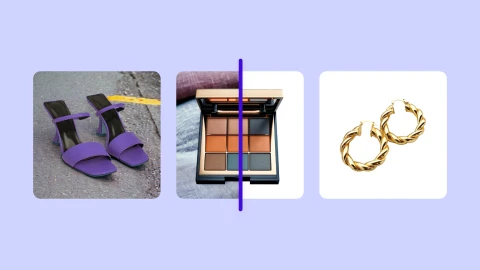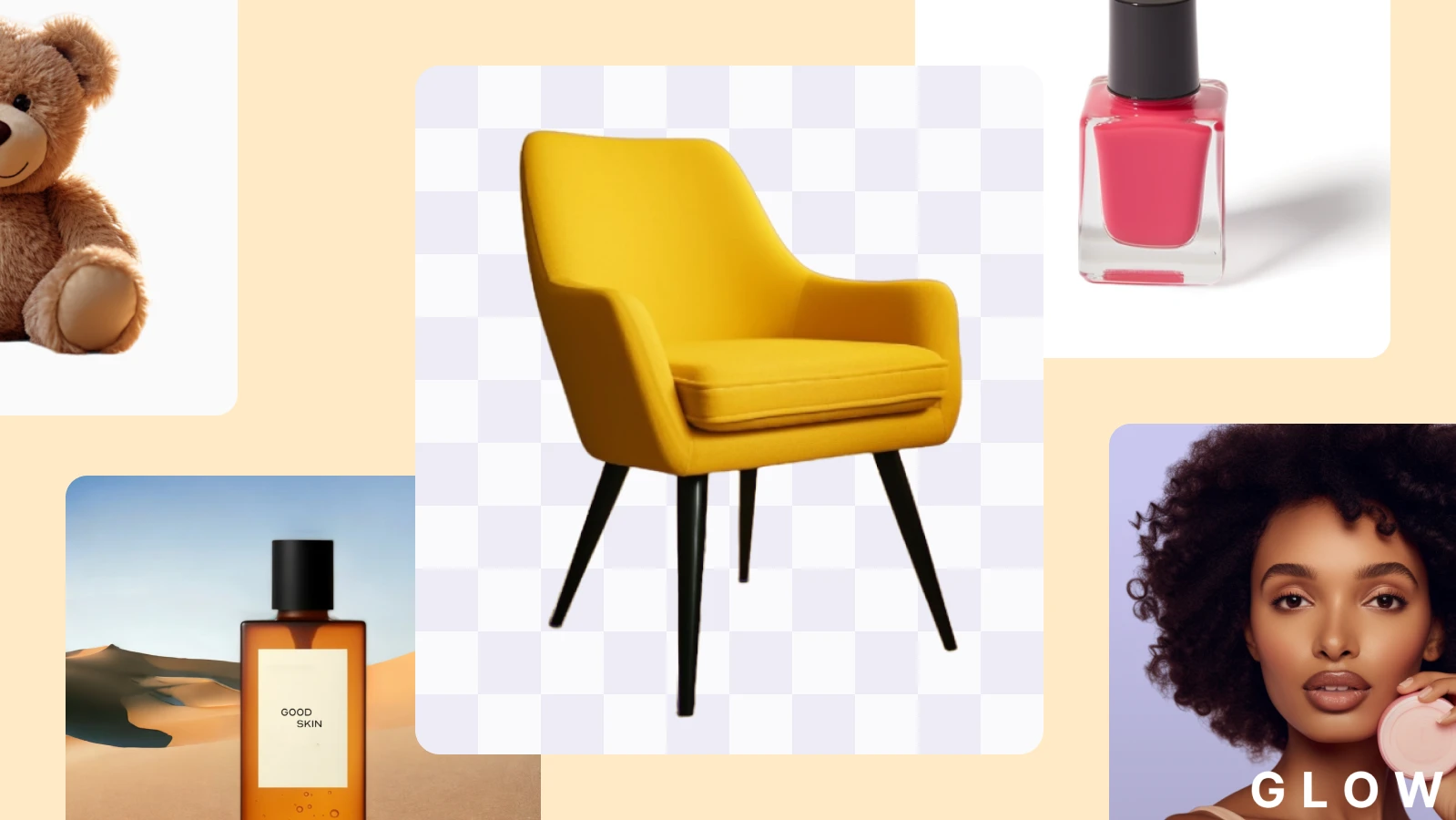How to photograph jewelry products like a pro


Photos do the heavy lifting in e-commerce. They catch the eye, hold attention, and often close the sale before words even get a chance.
Visuals are even more important for jewelry products. Shoppers can’t feel the weight of a pendant or see how a ring catches the light in person. Your photos have to do that for them. Good images build trust, showcase craftsmanship, and turn window shoppers into buyers.
This guide shows you how to hone jewelry photography like a pro. You’ll find ideas for shooting, backgrounds, and creating beautiful images without a studio or fancy gear.
💡 Start creating stunning product photos with Photoroom now →
Why jewelry photography matters
3.6 billion people will shop online by 2029. Great visuals ensure you capture the interest of this growing number of online shoppers, especially for delicate products like jewelry.
Here’s why jewelry product photography matters:
Improve visual appeal: It's usually hard to capture tiny details without unwanted glare in jewelry. But getting it right can make your products unforgettable.
Earn trust instantly: Crisp, detailed images signal quality.
Influence perceived value: High-quality photos can make a $50 ring look like it’s worth $500.
Shape your brand identity: Consistent visuals make your brand recognizable and strengthen your brand identity.
Turn moments into sales: 54% of jewelry purchases are tied to special occasions like birthdays. Themed photography provides context, helping the buyer imagine them as gifts.
Fuel organic engagement: Striking images get shared, liked, and remembered beyond your website.
Cut down on returns: Clear images reduce surprises, leading to fewer refunds and happier customers.
Essential tools for jewelry photography
1. Camera and lenses
A DSLR or mirrorless camera allows you to control settings like aperture, ISO, and shutter speed, making it easy to capture details. Some popular choices include the Canon EOS R5, Nikon D850, and Sony A7R IV.
That said, most modern smartphones have powerful cameras with advanced lenses. Paired with AI-powered visual assistants like Photoroom, they can deliver professional results with minimal resources.
For close-up shots, use macro lenses (like the Canon EF 100mm f/2.8L Macro and Nikon AF-S 105mm f/2.8G). They capture tiny details like gemstone facets or delicate engravings with sharp clarity.

2. Lighting
Jewelry needs soft lighting. Natural light creates soft, even tones. But it’s unpredictable. Artificial lighting like softboxes, ring lights, and LED panels help you control brightness and color temperature.
For gold jewelry, use warmer light to enhance the glow. For diamonds and silver, cooler tones bring out the brilliance.
Since jewelry is reflective, you’ll need a white sheet, diffuser, or light tent to reduce glare and soften reflections on shiny surfaces like gold or diamonds.

3. Tools for visual consistency
For your brand to look professional and become recognizable, you’ll need tools that help maintain sharpness, style, and quality across every shot.
Tripods keep your camera steady to prevent blur. Look for one with an adjustable center column for easy overhead shots.
Backgrounds set the tone for your photos. Use white or black paper background for a clean look, or add depth with acrylic sheets and textured surfaces like marble or fabric.
Display stands help show how jewelry looks when worn. Use Blu-Tack to keep items in place.

4. Photo editing software
Editing is where good photos become great. I recommend using an AI-powered platform like Photoroom that's designed for business owners and makes it incredibly easy to create professional product images.
With features like AI Upscale to enhance image quality, AI Shadows to add realistic depth, and AI Retouch to remove unwanted objects, you can easily refine your picture's details. It also offers tools to remove backgrounds, adjust brightness, add backgrounds, and batch edit multiple photos. These features help you produce studio-quality jewelry shots on your phone (iOS and Android) or browser (Web) without the steep learning curve of traditional editing software.
Ivonne Kronenberg, owner of Beadhouse, attracts new customers to her beaded jewelry using Photoroom’s AI photography tools.

Jewelry product photograph formats
There are different types of jewelry photos, depending on their uses.
Product photos: High-detail jewelry shots on a clean colored background. They focus exclusively on the product in fine detail and are typically for catalogs, product pages, and marketplaces.
Lifestyle photos: These show your product on a model or complementary background, helping customers visualize using your product. Use them for lookbooks, product pages, social media posts, and other sales and marketing collateral.
Scale photos: These provide context for the size of the piece, which can be difficult to gauge from standard product photos. Use a scale object recognizable to your target audience (e.g., place the jewelry next to a lipstick or model's hand).
Packaging photos: Use these to show how you’ll present the jewelry during delivery and set expectations for the unboxing experience. Spotlight outer pouches, inner cushions, special jewelry protection, and care instructions in the shot.

How to prepare your jewelry for the shoot
Before picking up a camera, use these tips to prepare for excellent shots.
1. Clean and polish the jewelry
Dust, fingerprints, and smudges are often visible in high-resolution shots. Use a microfiber cloth to gently polish each piece, focusing on reflective surfaces like gemstones and metal. For stubborn spots, you can use a soft brush and mild soap. Also, wear cotton gloves to avoid adding fingerprints.
2. Arrange the jewelry
The way you position jewelry shapes the story. Use stands or mannequins to mimic how pieces look when worn, or try flat lays for an editorial finish. For necklaces, a slight curve will feel natural. For rings, stack or stagger them to create depth. Don’t be afraid to adjust angles. Sometimes, a small tilt can transform visual appearance.
3. Select props
Use simple props that add meaning to the visual, such as a piece of textured fabric, a sprig of greenery, or a minimal ceramic dish. Take a subtle approach so that the prop can add interest without distracting the viewer from the jewelry.
4. Choose good backgrounds
Neutral backgrounds like white, black, or soft gray make jewelry pop. For warmth, try natural textures like linen, marble, or wood. If you’re using bold backgrounds, they shouldn’t overpower the piece. Also, I recommend using the same background style for all images to maintain your brand’s image. If you don’t have access to good background material, you can use AI in Photoroom to add a background while editing.

Step-by-step guide to photographing jewelry
Here’s how to take the best jewelry photos on your phone or with a camera.
1. Set up your workspace
Start by organizing the space where you’ll take the shots:
Clear the clutter: Remove any item that isn’t a prop and can crowd your image.
Set up lighting: Place your table near a window or prepare artificial lighting.
Stabilize your setup: Place your phone or camera on a tripod to prevent camera shake.
Position props: Place props in the right angles and corners to align with your vision.
Dust camera: Clean your camera lens to remove dirt or fingerprints.

2. Position your jewelry
Different pieces require different styles to stand out.
Necklaces: Drape them in a natural curve to mimic how they fall when worn.
Rings: Shoot at a slight angle to capture the band’s design.
Earrings: Wear them on a model or hang them on a thin line to show their natural drop. Lay them flat for symmetry.
Focus on the details: Use a macro lens or zoom in to capture engravings and other subtle details.

3. Apply lighting techniques
As mentioned, it’s best to use soft lighting for jewelry photos.
Diffuse the light: Use softboxes or white sheets to balance lighting and reduce glare.
Prevent harsh shadows: Add reflectors (e.g., white paper) to bounce light back onto dark spots.
Experiment with angles: Adjust your light source to find the best lighting level.

4. Take the shot
Now that everything’s in place, it’s time to take the shot.
Adjust camera settings: Use a low ISO (100-200) and small aperture (f/8-f/11). Adjust white balance to match your lighting. For phones, set the best zoom level, adjust the exposure, and disable flash mode.
Use manual focus: Controlling the focus creates sharp-looking photos, especially for close-ups.
Shoot from multiple angles: Capture front, side, close-ups, and lifestyle shots for versatility.
Apply subtle movement: Add a gentle breeze or sway the jewelry to capture a motion shot.
Don’t rush: Take your time, review shots as you go, and tweak your setup as needed.

How to edit jewelry photos
Once you’ve taken your photos, polish them with a reliable image editor. Here’s how to edit your product images using Photoroom’s AI tools:
1. Remove unwanted objects
Use the AI Retouch tool to remove elements that shouldn’t be in the image and reduce distraction.

2. Enhance image quality
Use the AI Upscale tool to sharpen details, remove blur, create a high-resolution image, and enhance image quality overall. You can also use the editing filters in the app to improve brightness or sharpen details.

3. Remove image backgrounds
Use the Remove Background tool to erase image backgrounds and get a versatile image you can layer over any background.

4. Add a new background
After erasing the background, add a custom background using the AI Backgrounds tool and good prompts. You can also opt for a colored backdrop like white or black to match your brand. If you use a plain color, use AI Shadows to add depth.

5. Adjust image dimension
Before sharing or publishing your images, use the Resize tool to change image dimensions for different platforms. It also has an AI Expand feature that automatically fills empty spaces after resizing, keeping the composition balanced.

6. Batch edit images
Save time using the Batch mode feature to edit multiple jewelry photos. It’s a simple way to apply the same edit on different images.

3 mistakes to avoid in jewelry photography
It’s normal to make errors when creating photos for your jewelry, especially when you’re just starting. Here are the most common mistakes and ways to avoid them.
1. Over-editing photos
You likely want to make gemstones or metals shine. However, excessive editing makes your product look artificial and can mislead and disappoint customers.
To fix, only make small adjustments while editing. Improve lighting before shooting, rather than overcorrecting in post-production. Use tools like Photoroom’s AI Retouch to remove minor imperfections without distorting the jewelry’s natural beauty.
2. Ignoring reflections
Jewelries are made of metals and gems, which typically cast reflections. Don’t overlook this fact while shooting. Reflections can overshadow the jewelry and make your effort worthless.
Use soft-even light and diffuse your light source with a white sheet or light tent, as mentioned earlier. Adjust the angles of your jewelry or lighting to manage shadows.
3. Inconsistent lighting and backgrounds
One of the biggest mistakes you can make is being inconsistent with your shots. People notice the intensity of your lighting and the type of background you use. The more they come across your photos, the more your brand sticks to memory for having a specific style. This builds brand recognition and trust over time, which drives business growth.
To stay consistent, stick to a specific lighting setup and background style. If you need to standardize older images, use Photoroom’s background remover and background color and image tools to create a uniform look.
Master jewelry photography
Great jewelry deserves great photography. Buyers notice clarity, craftsmanship, and how light plays on metal and stone. So, apply the tips in this guide to set your brand apart and catch customer interest.
As you create, remember that you don’t need a high-end studio to capture the beauty of your jewelry. Stick to effective techniques and use the photography tools in Photoroom (iOS, Android, or Web) to create jewelry photos that sell.
















